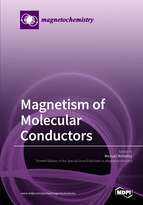Magnetism of Molecular Conductors
A special issue of Magnetochemistry (ISSN 2312-7481). This special issue belongs to the section "Magnetic Materials".
Deadline for manuscript submissions: closed (30 April 2017) | Viewed by 61833
Special Issue Editor
Interests: electrical and magnetic properties of materials; multifunctional and nanostructured materials; molecular conductors; molecule based magnets; low dimensional conductors; crystal engineering
Special Issue Information
Dear Colleagues,
The study of the magnetic properties of molecular conductors has experienced, during the last few decades, a very significant evolution comprising systems of increasing molecular complexity, and moving towards multifunctional materials. In this context, molecular magnetic conductors recently emerged at the intersection between the fields of molecule-based conductors and molecule-based magnets, as a very exciting class of multifunctional materials, where the interplay between charge, structure, and magnetism in general, and particularly the interaction and synergy between conduction electrons and localized magnetic moments, can lead to new phenomena, complex phase diagrams and ground states, with a large potential of technological applications namely in electronic devices and in spintronics. Among these phenomena are unusual field induced transitions including magnetic field induced superconductivity, very large magnetorresistence effects, switchable conductors by magnetic field, changes of magnetic ordering, spin state, etc.
This Special Issue of Magnetochemistry aims at publishing a collection of research contributions illustrating the recent achievements in all aspects of the development, study and understanding of the magnetic properties of molecular conductors and their applications, namely in the topics listed below.
Prof. Dr. Manuel Almeida
Guest Editor
Manuscript Submission Information
Manuscripts should be submitted online at www.mdpi.com by registering and logging in to this website. Once you are registered, click here to go to the submission form. Manuscripts can be submitted until the deadline. All submissions that pass pre-check are peer-reviewed. Accepted papers will be published continuously in the journal (as soon as accepted) and will be listed together on the special issue website. Research articles, review articles as well as short communications are invited. For planned papers, a title and short abstract (about 100 words) can be sent to the Editorial Office for announcement on this website.
Submitted manuscripts should not have been published previously, nor be under consideration for publication elsewhere (except conference proceedings papers). All manuscripts are thoroughly refereed through a single-blind peer-review process. A guide for authors and other relevant information for submission of manuscripts is available on the Instructions for Authors page. Magnetochemistry is an international peer-reviewed open access monthly journal published by MDPI.
Please visit the Instructions for Authors page before submitting a manuscript. The Article Processing Charge (APC) for publication in this open access journal is 2700 CHF (Swiss Francs). Submitted papers should be well formatted and use good English. Authors may use MDPI's English editing service prior to publication or during author revisions.
Keywords
- The molecular approaches to the preparation of Multifunctional electrical and magnetic materials
- π-d interactions in molecular conductors
- Magnetic conductors
- Magnetic Superconductors
- Field induced superconductivity
- Spin Crossover conductors
- Photomagnetic response in molecular conductors
- Photo switchable spin-crossover molecular conductor
- Magnetic field induced transitions.
- Magnetic response of strongly correlated electronic systems






